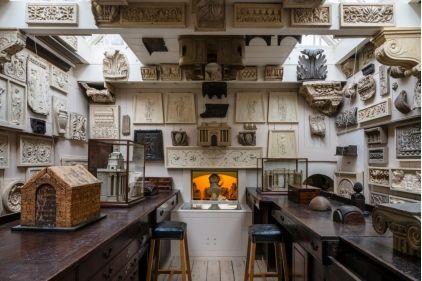After 200 years of secrecy, John Soane’s drawing office—the oldest surviving example of its kind— is now open to the public.
The historic British architect built, lived and worked in the tall, stately buildings that overlook Lincolns Inn Field, London, for much of his life.
His former home and office is now a museum dedicated to his legacy. But, high up inside the Sir John Soane’s Museum, a room has stood unseen for the last 200 years. It was, the museum director says, the “creative heart” of Soane’s practice.
Within the tight confines of the so-called drawing office, Soane’s draftsmen and apprentices worked with Soane on the designs that shaped the neo-classical architectural character of Regency era London.
Now, after a year of restoration works, visitors can see the room where Soane created the blueprints that would change the course of architecture in London.
“The Drawing Office was the last major element of the fabric of the museum to be restored,” said Bruce Boucher, the director of the Sir John Soane’s Museum, in a statement.
The son of a humble bricklayer from a small village in Oxfordshire, Soane rose to become one of the UK’s most influential architects. His designs include the Bank of England (although his original work on the building has now largely been destroyed) and the Dulwich Picture Gallery.
Soane’s designs were deeply influenced by his studies of ancient Rome, the ancient Greek city of Paestum and the archaeological remains of Pompeii. Soane visited each site as a young man during a tour of Europe funded by King George III via a bursary.
Today, the Sir John Soane’s Museum occupies three buildings on Lincolns Inn Fields. Soane bought and rebuilt each of the buildings during his lifetime, acquiring the first building, at that time a 17th century house, in 1792. Soane largely demolished the building, rebuilding it in his own vision as his bespoke home and office, choosing the location as it was situated between the Bank of England, which he designed and helped to construct, and the Royal Academy, then in Somerset House, where he worked as a professor of architecture.
During the restoration, the conservation team made a fascinating discovery. Hidden in the hollow base of a supporting column, they found a pipe with tobacco still in the bowl and a railway ticket from South Kensington in London. Conservators at the museum believe it was probably left by a craftsman during earlier restoration works at the Soane in 1928.
To mark this discovery, a new time capsule has been placed within the repaired structure in the office. The Soane’s Head of Conservation, Jane Wilkinson, has left a paintbrush, a small jar of gold leaf and a recent invoice for a can of paint for future conservators to find.

























